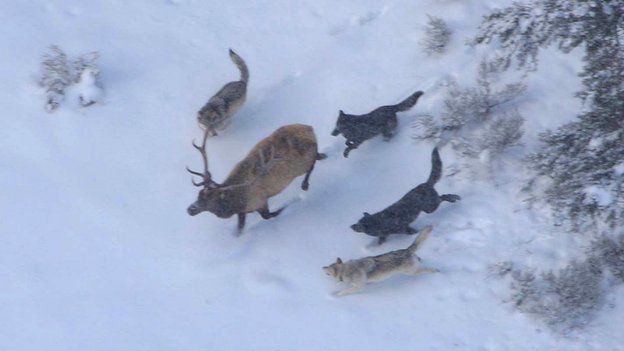Yellowstone wolves spur recovery of bears' berries
- Published

The return of wolves to Yellowstone National Park may be leading to an improvement in the diet of grizzly bears, a study suggests.
When wolves were eradicated from Yellowstone in the early 20th Century, the elk population boomed, devastating berry-shrubs relied upon by bears.
Details are published in the Journal of Animal Ecology.
A team from Oregon and Washington links the reintroduction of predatory wolves with a fall in over-browsing by elk.
There is a consequent recovery in the availability of late-summer berries, the favoured pre-hibernation food of the grizzly bear.
The study indicates that the number of berries measured in bear droppings has doubled as elk numbers have decreased, following the wolves' return in the 1990s.
The complex interactions of the Yellowstone ecosystem were revealed in data measured before and after the reintroduction of wolves.
Can humans and wolves co-exist?
David Mattson, a US Geological Survey (USGS) wildlife biologist, commented previously on Yellowstone: "It's a complex system and grizzly bears are a kind of consummate connector of all of the species in that system."
The study shows that berry shrubs have increased since elk populations declined, and as shrubs recover from over-browsing the fruit consumption of bears has increased.
William Ripple, lead author, commented: "Wild fruit is typically an important part of grizzly bear diet, especially in late summer when they are trying to gain weight as rapidly as possible before winter hibernation".
"Elk browsing reducing berry production is well known in Europe as well," said Atle Mysterud, an ecologist from the University of Oslo.
"The study shows that new patches of berries have formed after the wolves were reintroduced. It is clear that berry production is very important for bears."
But the reduction in elk may not be all good news. Yellowstone's northern elk population hit 19,000 in 1988, but last winter the herd was estimated to number just 3,900 animals.
Elk calves are an important food source for grizzly bears in the spring and Arthur Middleton of Yale University suggests that the decline in elk may pose a threat to the grizzly bear rather than a benefit, since their other spring food source, cutthroat trout, is also in decline.
"This is an interesting paper and it is important that we understand the consequences of wolf recovery", Dr Middleton added.
"But wolf re-introduction is not the only change that has occurred in recent years in Yellowstone. Bears eat elk and bear numbers have increased three or four times during this period.
"Bears and wolves together reduce elk numbers, and it may be that as elk numbers have declined some bears have sought out alternative foods such as berries, separate from any benefits of shrub re-growth.
"Unfortunately, as wildlife ecologists working in a vast landscape such as the greater Yellowstone ecosystem it is very difficult to unravel the complexity of the patterns."
The latest results demonstrate that acknowledging the many inter-relationships between species and environments in these systems is key to understanding that complexity.
- Published29 May 2013
- Published8 March 2011
- Published3 September 2010
- Published12 September 2009